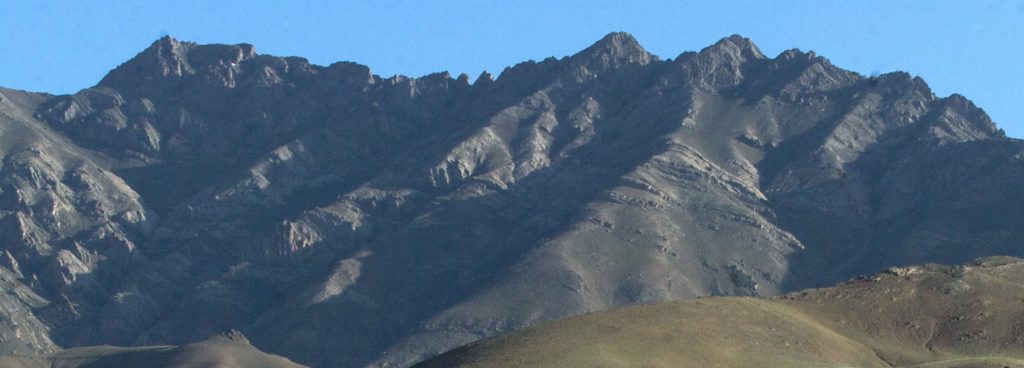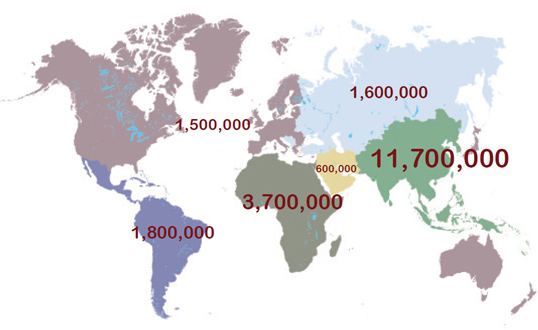
500 nuns cycled across the Himalayas to raise awareness about human trafficking. Here’s what they want you to know
Earlier this month, a group of 500 cyclists travelled across 4,000 kilometres of Himalayan terrain from Kathmandu, Nepal to the northern Indian city of Leh, to raise awareness about human trafficking. Those cyclists were the Drukpa Buddhist order, otherwise known to the press as the 'bicycle-riding, kung-fu fighting nuns'.
… So what's going on here?
The Drupka nuns set out on their cross-border tour with a serious mission in mind: to educate those they came into contact with about the hidden problem of human trafficking. Reports estimate that around 10-15,000 people are trafficked from Nepal each year, a figure that spiked after the earthquake which struck the country in April 2015. The majority of victims are taken along similar routes into India.
Linked with systemic problems of gender discrimination and inequality, it’s women and girls who are most at risk from the criminal gangs who run the trade. Twenty-two-year-old Jigme Konchok Lhamo explained how this inspired the nuns to action: "We wanted to do something to change this attitude that girls are less than boys and that it's okay to sell them."
What exactly is human trafficking?
As defined by the UN Office on Drugs and Crime (UNODC), human trafficking is “the acquisition of people by improper means such as force, fraud or deception, with the aim of exploiting them.”
A central characteristic among those who fall victim to trafficking is their vulnerability to exploitation. “Unstable atmospheres in the wake of huge disasters give criminals the chance to traffic and enslave vulnerable people,” says Anuradha Koirala, founder of NGO Maiti Nepal.
The main forms of exploitation faced by trafficking victims are either forced labor exploitation or commercial sexual exploitation, along with state-imposed forced labor and even, in some cases, trafficking for the purposes of organ removal.
Although a lot of people associate trafficking with cross-border movements, but that’s not always the case. According to the UNODC, most are trafficked close to home or within their region.
How big an industry is this?
According to International Labor Organization (ILO) estimates from 2012, there are around 21 million victims of this 'modern slavery' worldwide: 55% of these are women and girls, and 26% are children.
Exploitation is big business. The ILO reports that modern slavery generates profits of around $150 billion each year, making it the third most lucrative form of illicit business after drug and arms trafficking.
Commercial sexual exploitation is estimated to make up the majority of the profits from global trafficking at $99 billion a year. Labor exploitation meanwhile is thought to account for a further $51 billion, including:
· $34 billion in construction, manufacturing, mining and utility industries
· $9 billion in agriculture, forestry and fishing industries
· $8 billion through non-payment or underpayment in domestic work

The dark trade is expanding fast, with few areas left untouched: between 2010 and 2012, national authorities reported victims of 152 different nationalities in 124 countries. The highest number of victims (11.7 million) is concentrated in the Asia-Pacific region, where the trafficking economy is estimated to be worth $51.8 billion each year.
What effect does trafficking have on our economies?
We’re constantly trying to assess how well our economies are doing, asking questions like how many people are in secure jobs and whether the wages they’re earning are fair. But the size and scale of this $150 billion trade means that the trafficking economy is now a fundamental part of so many industries that it becomes impossible to claim the global economy is set up in a way that could be described as ‘fair’ or ‘functioning’.
How could it be stopped?
In many cases, trafficking is considered a form of 'transnational organized crime', and in recent decades several international agreements have been signed to try to address the problem. Over 90% of countries worldwide now have legislation criminalizing human trafficking.
But national authorities often struggle to keep up, and the overall level of prosecutions remains remarkably low. Global reports from US State Department recorded just 18,930 prosecutions for trafficking offences during 2015, resulting in a total of 6,609 convictions.
And, while these responses are limited in their success, the UNODC considers even the existing estimates to be “only the tip of the iceberg.” Given the illicit nature of the trafficking underworld, the search for accurate data – let alone pursuit of prosecutions – can prove near impossible.
A number of new initiatives have been launched to continue the fight against trafficking. The United Nations included the eradication of forced labor and human trafficking as a target in the Sustainable Development Goals, and the European Union recently announced a joint initiative with the UNODC to encourage the development of worldwide anti-trafficking programmes.
These nuns cycled 4,000km to raise awareness about human trafficking. For them, and for the 21 million trafficking victims, let's bring this issue into the open
Thanks to the campaigns of those like Nepal’s ‘bicycle-riding kung-fu fighting nuns’, more and more people are becoming aware of the scale and complexity of trafficking, and the effects it has on our global economy. The more that is done to bring the issue out into the open, the more that can be done to protect the vulnerable, and counter those who seek to profit from their exploitation.



